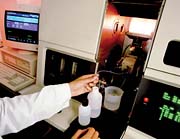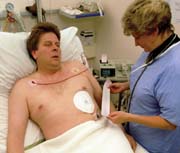
Issue: 4/04
Every day, millions of Americans seek treatment or consultation from area hospitals or medical facilities. While these people generally get the help they need, are they exposing themselves to possible illness simply by drinking from the hospital water fountain?
The American medical community is generally regarded as the best in the world at their profession: medicine and medical-related procedures. Unfortunately, they are only adequate at best when it comes to knowledge and understanding of backflow prevention and cross-connection control. Why? It is easy to cast blame-from the federal government's issuance of the Safe Drinking Water Act of 1974 to the local plumber who installs the backflow protection assembly. All disciplines of the plumbing industry must share this responsibility. Safe, clean water is everyone's concern.
This article reviews an actual medical facility, looking at the things that were done properly, as well as the things that were done improperly or not done at all. Possible explanations and options to improve or correct faulty or nonexistent installations will also be presented.

The Need for Containment Assemblies
The project begins on the drawing board of an architect-designer and then moves on to the desk of the plumbing and mechanical design professionals, where the piping systems will be fitted into the envelope of the building. All the parts must not only fit together but should look good when the project is complete. Unfortunately, it is the "looking good" part that can be problematic, allowing aesthetics to take precedence over future repair or periodic required maintenance considerations.With all the varied procedures taking place in a medical facility, cross-connection control is vital to prevent backflow problems, but it is sometimes overlooked. Consider the following scenario involving containment of both the domestic and fire protection systems, located in the boiler and equipment room. Both systems are protected by reduced pressure backflow preventers (RPBPs), with 4-inch on the domestic and 8-inch on the fire line. Both assemblies were installed properly, with adequate thought given to future maintenance. This system properly protects the public water supply from the facility.
The problem in this situation arises when you look inside the facility at the various cross-connections located throughout the facility that go to other areas, such as outside irrigation, inside planters and ponds, cooling towers, exam rooms with water-supplied appliances, x-ray developers, dialysis rooms, computer room cooling systems, and janitorial closets. At any one of these points, contaminated water can backflow into these systems, unless isolation assemblies are installed.
Isolation assemblies are installed at point-of-use to protect the potable water inside the building from potential contaminants and pollutants located inside the facility itself. The word "assembly" is used to describe what the backflow preventer is. They are tested and prepackaged as a complete unit, including two shut-off valves and four test ports-three on the body of the valve and one on the first shut-off valve.
Containment vs. Isolation Assemblies
This medical facility has both "containment" and "isolation" assemblies. Are they both, or either, always necessary? The answer is "no." Why?
Naturally, we do not want to waste the developer's money or cause a contractor to lose money. And redundant installations-i.e., installing a containment assembly when isolation will adequately do the job-can be considered overprotection. In many cases, the concept of containment or protection of the public water supply can adequately be handled with the installation of one or two small isolation (point-of-use) assemblies that are properly located and installed. There are times, however, when a containment assembly must be installed at the time of construction-for instance, a strip mall with a single water supply. Because we have no idea what type of tenants will occupy the different spaces, containment is necessary. And it is particularly necessary with a hospital or medical center.
The Need for Proper RPBP Location
Moving forward in our survey of the facility, we find a 2-inch water supply, also located in the boiler room, for the cooling towers located outside of the building. Neatly installed is a 2-inch RPBP located in the ceiling between all the pipes and ductwork. Although the protection is proper, the location is pitiful. Why? It is at least 10 feet up in the air and would take a contortionist to get to it for testing or repair maintenance.
RPBP maintenance should be scheduled at least annually to ensure that all assemblies are working properly. This maintenance is the reason why the assembly must be relocated to a lower, more easily accessible location.
The Need for Properly Installed Pressure Breakers
Leaving the facility itself and going outside, we find four pressure vacuum breakers (PVBs), all 1.5-inch in size. Two are installed properly, at least 12 inches above the highest line of piping they serve. Two are incorrectly installed. Although they are at least 12 inches above the ground, they are located next to vehicle service doors that are at basement level, more than eight feet below the grade of the ground they serve.
Why is this a problem? A PVB cannot be subjected to backpressure. These two assemblies must either be relocated to a position 12 inches above the highest line of pipe they serve or be replaced with RPBPs.

The Need for Proper PVBs
Back inside we find an impressively large atrium that includes a pond with circulation and make-up water supply. Due to the complexity of the atrium, there are three PVBs for irrigation, as well as an air gap for the pool feed. All are properly installed and adequately protect the water supply. Why is it necessary to have three assemblies and an air gap to do the job that one RPBP located in the mechanical room could do for less cost and far less danger of being damaged? The answer is, "It's not." This is an example of an unnecessary and costly assembly.A medical facility this size has a rather large x-ray development center. All the developers in this case are protected by three chrome-plated PVBs installed six feet up on a wall inside an electrical equipment room, directly over and centered above three telephone switching cabinets. It looks good and protects the water supply. What is the problem?
To begin with, PVBs were never intended for inside installations-even if they are chrome-plated-and they should never be installed above sensitive electrical equipment, such as a telephone switch. They must be relocated and replaced with either three spill-resistant vacuum breakers (SVBs) or one RPBP of adequate size.
While on the topic of chrome-plated vacuum breakers, there are several exam rooms for specialized medicine that require water for portable equipment. Each room is piped with a PVB located high on the wall or in the ceiling above the exam area. Remember the problem of spillage from a PVB? These units are causing water problems in every case, mainly due to the location of the shut-off or control valves in front of the backflow preventer.
The solution is to replace all of these PVBs with an approved SVB. Keeping in mind the need for annual testing and repair, they should be relocated in an easily accessible location.
Other Potential Problem Areas
There are several other areas in this medical center that could cause backflow problems if they are not recognized and treated. Let's take a look at a few of them.Dialysis Room. This facility has a multi-bed dialysis room. Each bed is individually protected by an RPBP located inside a cabinet behind the bed. Is this a problem area? This is a questionable call when it comes to accessibility, although the protection is proper with a correctly installed air-gapped drain. Serviceability is a problem, however, and the relief could leak, indicating a fouled valve with no one recognizing there was a problem until a real flood occurred.
Janitor's Closets. This is another very real source of trouble. More often than not, after construction, soap and chemical dispensers are added. Although nearly all janitor's sink faucets are equipped with a vacuum breaker integral to the faucet, this protection is nullified when hoses are installed to feed dispensers and valves added downstream. This problem could be eliminated by the installation of an SVB on a line dedicated to supply such equipment, or by the use of non-water supplied dispensers.
Another potential trouble spot involves the water supply to cooling units located in the ductwork for individual office suites. These backflow preventers are very often located in the ceiling above the janitor's closet, concealed by ceiling tiles. While accessibility is a very real problem, another concern is knowing or remembering about the existence of these cooling units to ensure that annual testing and routine maintenance are conducted.
Dental Facilities. This particular medical center happens to have a dental wing, which adds yet another set of cross-connection potential problems. A dedicated 1-inch water line services this suite of offices, causing me to believe that either the designer knew there is the possibility of danger here, or the wing was an afterthought. This water line has no protection on it where it leaves the main, and it should. An RPBP must be installed to isolate the wing due to the possibility of frequent equipment changes in the dental offices.
There is one central vacuum pump for all the dental chairs in the wing, protected by a PVB, installed two feet above the pump unit. The problem is that the pump is located in the basement, and the chairs are all on the first floor. This PVB must be removed and an RPBP installed to replace it. The chairs are all fine, with air-gapped water to the cuspidors and glass fillers.
Dental offices also use x-ray equipment that needs to be inspected. The x-ray developer has the AVB, with solenoid valves downstream, installed by the equipment supplier, which must be removed and replaced with an SVB or RPBP, depending on the installation location.
Boiler and Machinery. Let us go back to the boiler and equipment room. This facility has three large boilers and one small, residential-style boiler. The three large boilers are protected by a properly installed RPBP; however, the small boiler has only a vented dual check installed for protection. It is a wise practice to ensure that all boilers installed in commercial facilities have an RPBP. They may not be chemically treated, but they are chemically cleaned. In this medical facility, a separate water line was used to supply the small boiler, which was probably unnecessary. The boilers are all in the same area, and a branch off the protected line could or should have been used. When installing an RPBP on the water line to any boiler, it should be installed before the pressure-regulating valve, as it takes at least six pounds of pressure to flow through an RPBP.
The Basement. Many might ask why you would install RPBPs below grade, in the basement. It is true that RPBPs arguably should not be located below grade where adequate drainage could be a problem. Why? When a large RPBP goes into full dump, a 4-inch drain will not adequately carry the water away. Remember those vehicle service doors mentioned above? In this building, each door is located adjacent to the area where the RPBPs are installed. Roll-up garage-type doors, even when closed and locked, do not seal completely, thereby allowing water to flow under or around the sides.
Conclusion
The purpose of this article is to help those of us in the plumbing industry give a little more thought to just how safe or unsafe our drinking water really is. As shown by our medical facility tour, physically examining all areas of a facility with eyes wide open and asking many questions can prevent a costly backflow incident. And the cost is not all financial. Should this happen in your house or office, a relatively small number of people will be affected. However, if a backflow problem should occur in a hospital, where people are already ill with suppressed immune systems, the results could be catastrophic.The job of plumbing professionals-whether designers, installers, or inspectors-is to protect the public by protecting the public water supply. Doing so involves installing the proper backflow prevention devices and making sure those devices are properly maintained, as backflow protection assemblies are mechanical devices that require at least annual testing and periodic maintenance. Neglecting this is neglecting public safety.
If we have all done our jobs properly, the next time you're in a hospital, making sure that the water you drink-or the water your child or grandchild drinks-is safe is the least of your worries.
